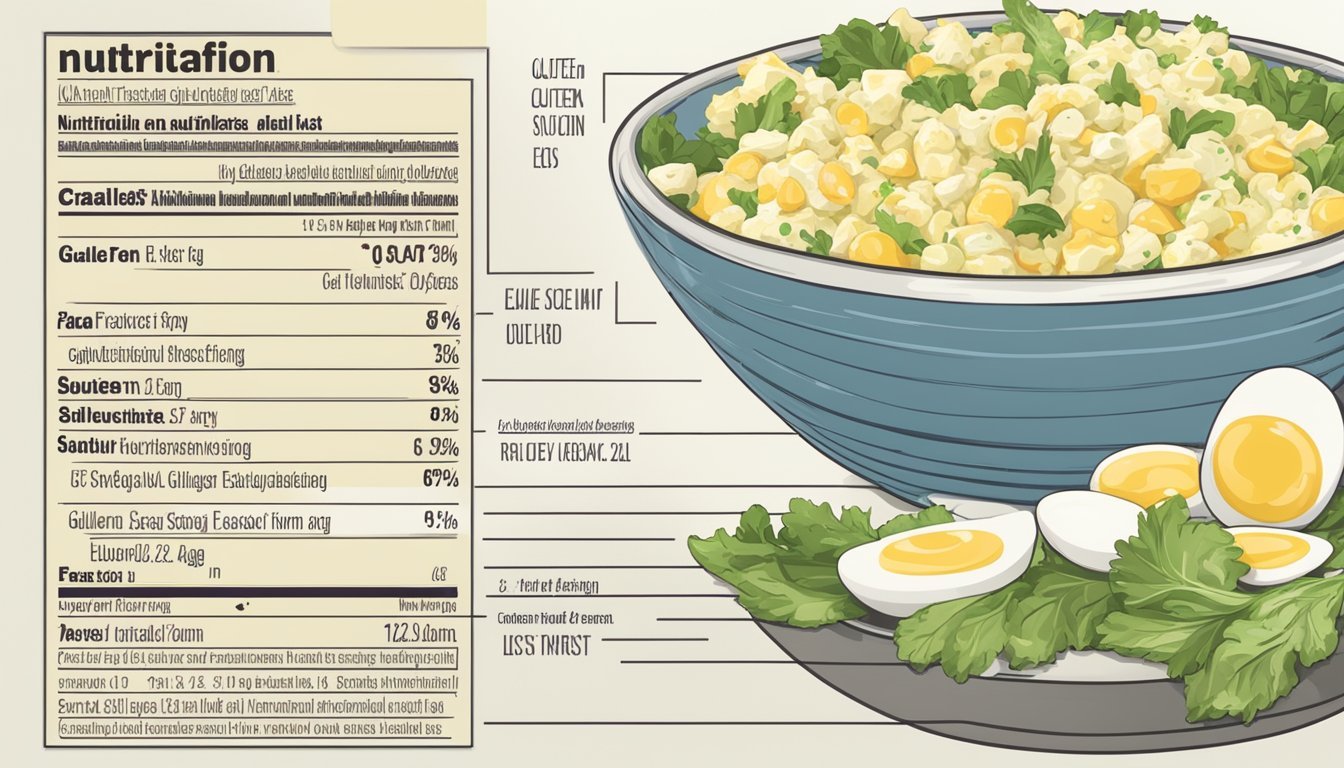Is Egg Salad Gluten-Free?
Determining its Dietary Compatibility
Egg salad is a classic dish known for its simplicity and versatility. At its core, it typically includes chopped hard-boiled eggs, mayonnaise, and seasonings like salt, pepper, and mustard. When made with these ingredients, egg salad is inherently gluten-free, as none of these components contain gluten, which makes it suitable for individuals with celiac disease or gluten intolerance.
However, when egg salad is prepared as a sandwich filler or served on crackers, the gluten content can change depending on the bread or crackers used. Gluten is a protein found in wheat, barley, rye, and triticale, and it is present in many breads and baked goods. Therefore, to maintain the gluten-free integrity of egg salad, it's essential to pair it with gluten-free bread or alternative serving options such as lettuce leaves or gluten-free crackers.
Care should also be taken when including additional ingredients or purchasing pre-made egg salad, as certain additives or preparations might introduce gluten into the dish. For example, some recipes may include pickles or pickle brine for added flavor, both of which are typically gluten-free, but verifying the labels for any hidden gluten is always prudent. Gluten can also be introduced through cross-contamination in a kitchen where gluten-containing products are handled. Therefore, it's critical to ensure that all ingredients are gluten-free by checking labels and to prepare the egg salad in a gluten-aware environment, especially when serving those with gluten sensitivities.
Understanding Gluten and Its Sources
Gluten is a type of protein commonly found in grains such as wheat, barley, and rye. It's responsible for the elastic texture of dough, enabling it to rise and maintain its shape, as well as providing a chewy texture in baked products. Gluten is an integral component in a variety of foods, especially baked goods like bread and pastries.
People with celiac disease or gluten sensitivity must avoid gluten as it triggers harmful reactions in their bodies. Therefore, identifying gluten-containing ingredients is crucial for these individuals. While foods made from wheat, barley, and rye naturally contain gluten, others may become contaminated during processing.
Gluten-free diets have necessitated the development of alternative ingredients to traditional flours. These substitutes include rice flour, corn flour, almond flour, and other gluten-free blends. Items marketed as "gluten-free" must comply with specific regulations that limit the amount of gluten to a minuscule level deemed safe for people with sensitivities.
Here is a quick guide to common sources of gluten:
Grains to Avoid:
Wheat (all varieties)
Barley
Rye
Gluten-free Alternatives:
Rice
Corn
Quinoa
Buckwheat
GF-labeled products
It's important for consumers to read labels carefully, as gluten can be hidden in additives or flavorings. In the context of egg salad, one must ensure that all ingredients, such as mayonnaise and mustard, are labeled gluten-free to avoid inadvertent consumption of gluten.
Essential Ingredients of Egg Salad
Crafting a perfect egg salad primarily involves combining boiled eggs with a binding agent like mayonnaise and adding various flavor enhancers and textures. For those needing a gluten-free option, certain substitutes ensure the salad remains safe to consume without sacrificing taste.
Eggs
Eggs are the foundation of any egg salad recipe, providing essential protein. Typically, hard boiled eggs are used, chopped to the desired size.
Binding Agents
A binding agent is critical for texture and creaminess. Mayonnaise is the most common, but alternatives like Greek yogurt or avocado oil mayo offer lighter or healthier options.
Flavor Enhancers
Flavor is built through mustard (such as dijon or spicy), vinegar, or lemon juice. Adding a tangy flavor can be achieved with pickle brine or yellow mustard.
Add-ins for Texture and Taste
For added crunch and flavor, diced celery, onions (white, red, or green), or pickles are popular. Bacon bits or cheese crisps can provide extra savoriness.
Gluten-Free Substitutes
Gluten-free diners can still enjoy egg salad by using gluten-free bread or lettuce wraps as a base and ensuring all condiments and add-ins like mustard and mayonnaise are certified gluten-free.
Herbs and Spices
Herbs like fresh dill, parsley, and chives add freshness, while spices such as paprika, curry powder, and ground black pepper enhance the overall flavor profile.
Egg Salad Variations
Egg salad can be customized: chicken, tuna (What wine goes well with tuna?), or avocado offer different proteins and tastes, while variations like chicken salad or tuna salad follow similar preparation methods.
Optional Dressings and Condiments
Condiments such as hot sauce, relish, or fresh lemon juice can be added to preference. Curry powder or kosher salt can vary the recipe to cater to specific palates or dietary needs.
Preparation and Cooking Techniques
In this section, readers will learn the key steps to prepare and cook eggs for egg salad as well as how to mix the correct seasonings and serving suggestions for a delightful gluten-free dish.
Cooking Eggs
For perfect hard boiled eggs, place the eggs in a saucepan or use an Instant Pot for convenience. When using a saucepan, cover the eggs with cold water, add a pinch of salt and bring to a boil. Once boiling, reduce the heat and let them simmer for 10 minutes. Alternatively, in an Instant Pot, place the eggs on the trivet, add a cup of water, and steam under high pressure for 5 minutes, followed by a 5-minute natural release and then a quick release. Immediately transfer the eggs to a bowl of ice water to stop the cooking process and ensure easy peeling.
Mixing and Seasoning
In a mixing bowl, chop the hard boiled eggs into small pieces or use an egg slicer. Add mayonnaise for creaminess; a traditional recipe may call for a cup of mayonnaise for a dozen eggs. Incorporate mustard, either yellow or Dijon, and fresh lemon juice for zest. Season with black pepper and a pinch of salt. To ensure the salad is gluten-free, always check that the mayonnaise and mustard are labeled as such, as some brands may include additives that contain gluten.
Serving Suggestions
Egg salad can be served in a variety of ways, suiting different dietary needs and personal preferences. Spoon the prepared egg salad onto gluten-free bread for a classic sandwich or into lettuce wraps for a lighter option. Alternatively, serve on a bed of greens, in lettuce cups, or with gluten-free crackers for a satisfying snack. If one desires a carbohydrate component without the gluten, they can opt for gluten-free wraps or bread as carriers for the egg salad.
Gluten-Free Considerations in Cooking Egg Salad
When preparing a gluten-free egg salad, one must be vigilant about the ingredients and their preparation to avoid cross-contamination. Here are the crucial considerations:
Ingredients Selection:
Mayonnaise: Select mayonnaise that's certified gluten-free. Brands vary, so check the labels carefully.
Mustard: Use gluten-free varieties, as some mustards may contain gluten.
Spices and Seasonings: Verify that spices like salt and pepper, or any seasoning mixes, do not contain gluten as a binder or filler.
Add-Ins: Common additions like celery must be fresh and not processed or packaged with products that contain gluten.
Preparation Space:
Clean Surfaces: Thoroughly clean kitchen surfaces before preparing a gluten-free egg salad to prevent cross-contamination.
Utensils: Use separate kitchen utensils that are clearly marked for gluten-free cooking or have been thoroughly washed.
Serving Options:
Sandwich/Wrap: Serve the egg salad using gluten-free bread or wraps to ensure that the meal remains gluten-free.
Crackers: Offer gluten-free crackers as a pairing with the egg salad. Always check the packaging to confirm gluten-free status.
Garnishes: Garnish with gluten-free items such as fresh herbs or gluten-free spices.
Staying educated on the ingredients and maintaining a clean and separate preparation area are key to successfully creating a gluten-free egg salad. It is always important to read labels and if uncertain about a product's gluten-free status, one should contact the manufacturer directly.
Storing and Shelf Life of Egg Salad
When it comes to egg salad, the key factors ensuring its freshness and safety are proper refrigeration and adherence to food safety guidelines for storage.
Refrigeration
Egg salad should be promptly placed in the refrigerator at 35 to 40°F to maintain its quality. Stored in an airtight container, it can be safe to consume for 3-5 days. Beyond this period, the risk of bacterial growth increases, thus it is not recommended to consume egg salad.
Best Practices for Food Safety
Preparation and Container: Use an airtight container to store egg salad. This minimizes air exposure that can accelerate spoilage.
Cross-Contamination: Keep egg salad away from strong-smelling foods in the refrigerator to prevent odor absorption.
Leftovers: Label the container with the preparation date to keep track of its shelf life. If leftovers surpass the 3-5 days timeframe, they should be discarded.
Expiration Date: Always take note of the expiration dates of ingredients used, particularly mayonnaise, as this can influence the overall safety and quality of the egg salad.
Food Spoilage Signs: Before consuming, check for any signs of spoilage such as an off smell or change in texture, which indicate that the egg salad should not be eaten.
Nutritional Information
Egg salad is a nutritious dish that is naturally gluten-free and offers a rich profile of macro- and micronutrients. Depending on the ingredients used, it can cater to various diet plans, including low-carb and keto, while providing essential vitamins and minerals.
Macro- and Micronutrients
The primary ingredient in egg salad is eggs, which are an excellent source of high-quality protein, with about 6 grams per medium egg. They also contain healthy fats, predominantly monounsaturated and polyunsaturated fatty acids. Carbohydrates are generally low in egg-based dishes, making egg salad a low-carb option suitable for ketogenic diets.
Eggs also provide a range of essential vitamins and minerals, such as vitamin D, B12, selenium, and choline. When other ingredients like mayonnaise are added, one must consider additional fat content, which may be high in saturated fats depending on the type of mayonnaise used.
Protein: High (about 6g per medium egg)
Fat: Varies (account for type of mayonnaise used)
Carbs: Low
Health Benefits
Regular consumption of egg salad can contribute to a nutrient-rich diet, as eggs are packed with various vitamins and minerals that are essential for maintaining good health. The protein content in eggs provides sustainable energy and can assist with muscle repair and growth.
The healthy fats found in eggs can help with the absorption of fat-soluble vitamins and provide satiety, which helps in maintaining a balanced diet. As a gluten-free dish, egg salad is also beneficial for individuals with gluten intolerance or celiac disease.
Considerations for Dietary Restrictions
When preparing egg salad, individuals should consider all ingredients used to ensure the dish remains gluten-free. Additives in store-bought mayonnaise or mustards can contain hidden gluten, so one should check labels carefully, especially when addressing allergies or celiac disease.
For those looking for a healthy, low-carb, or keto-friendly version, alternatives such as Greek yogurt can replace mayonnaise to reduce fat content while maintaining the creamy texture. Enhancements like adding vegetables can increase fiber and nutrient content without compromising the gluten-free quality of the salad.
Ingredients to verify for gluten:
Mayonnaise
Mustards
Optional add-ins
Alternatives for health-conscious options:
Use Greek yogurt instead of mayonnaise
Incorporate fresh vegetables for added nutrients
Frequently Asked Questions
Is egg salad gluten-free?
Egg salad can be gluten-free, as eggs are naturally devoid of gluten. However, it's crucial to verify that all added ingredients, especially mayonnaise, are labeled gluten-free. Some mayonnaise brands may include gluten-containing ingredients such as wheat starch or modified food starch.
What ingredients are used in a traditional egg salad recipe?
Hard-boiled eggs
Mayonnaise
Salt and pepper
Optional additions: mustard, green onion, herbs
Can egg salad be used in various meals?
Yes, egg salad is versatile. It can be enjoyed on its own, as a filling in a sandwich or wrap, or as part of a larger meal prep plan. When using it in a sandwich or wrap, one must ensure the bread or wrap is gluten-free to maintain a gluten-free meal.
How should egg salad be stored?
Store egg salad in an airtight container in the refrigerator and consume within 3-4 days for optimal freshness.
Are there variations to the traditional egg salad recipe?
Indeed, there are numerous variations. One can add diced celery, onions, herbs like dill, or spices to enhance the flavor profile. For a dairy-free version, substitutes for mayonnaise are available.
Any tips for meal prepping with egg salad?
For those meal prepping, prepare a large batch of egg salad and divide it into individual portions. Keep it chilled until ready to serve. Always use fresh ingredients to ensure the salad remains fresh throughout the week.








